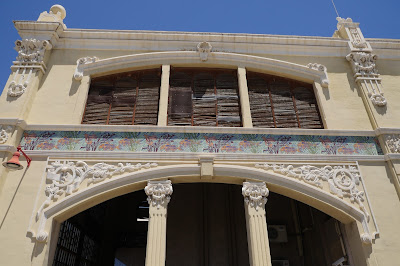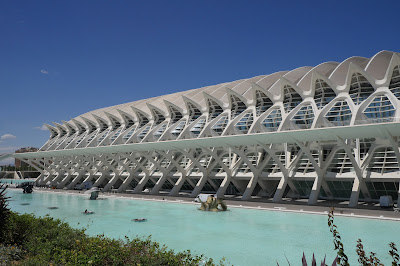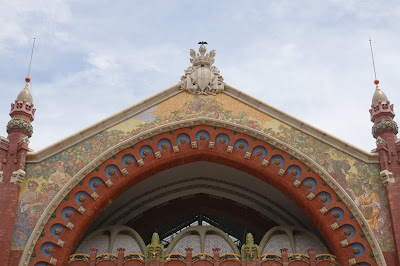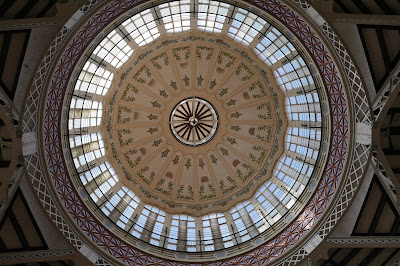Casa el Punto de Gantxo (Crochet Work House)
We spotted this wonderful building yesterday behind the Basilica of the Virgin of the Abandoned and decided to make it the start of our second
art nouveau (
modernisme in Spanish) walk in Valencia (see also the
Markets and Station walk). It is in Plaza de la Almoina and was the work of Manuel Perris Ferrando. A close up will illustrate the combination of the coloured facade with the extraordinary columns.
From here we headed to the Plaza de la Reina, in front of the Cathedral, where at the southern end are a nice pair of buildings. On the right is Casa Sanchez de Leon (1896, by master builder Luca Garcia).
And on the opposite corner is La Isla de Cuba (1896), with its fine relief figures. The design was also by master builder Lucas Garcia (shades of Ibsen).
We headed along Paz to see this lovely house, about which I can find nothing
At the end we turned into Calle Colon to soon turn left into Jorge Juan which leads to the celebrated Mercado de Colon (see
separate post). Immediately we were confronted with the extraordinary Casa del Dragon (1901, by Jose Manuel Cortina).
The facade on the right side has the most impressive dragon coiling at the bottom of a column. I had to omit part of its tail because a large rubbish bin was in the way.
After a thorough exploration of the Mercado, and a nice lunch there, we continued our walk. There were two pleasing houses adjoining each other in Carrer del Comte de Salvatierra at the back of the Mercado. Number 25 with its exquisite circular window was especially attractive.
Then we made a brief left into Carrer Ciril Amoros and enjoyed this lovely building at number 74. The carved roses are spectacular.
Now we doubled back and walked along Ciril Amoros towards Calle Colon, soon reaching, at number 29, the astounding Casa Ferrer (1907-08, by Vicente Ferrer Perez).
Here is a closer view of the rose decorations at the top.
We were lucky enough to find the main door open and so we had a quick look inside.
This was effectively the end of the walk - we headed back towards the city centre. However, I can't resist adding another couple of gems. The first is the Casa Ordeig in Plaza del Mercado, facing both the
Mercado Central and the
Lonja, or Silk Exchange. It dates from 1907 and was the work of Francisco Mora. Mora was also the architect of the Mercado Colon. The suggestion of battlements is presumably a nod to the medieval Lonja, but there are also some delightful flower motifs.
The site is very cramped and partly obscured by trees, but there are some lovely tiles and stonework on the right side of the building in Calle Ramiletes.
A bit northwest of Plaza del Mercado is this recently renovated house in Plaza del Mercat. I rather doubt that this was the original colour scheme, but the overall effect is excellent.
Conditions: hot and sunny again.
Source: some inspiration was taken from the
visit Valencia website, although the pictures are poor and the map illegible. There are also clearly many more good art nouveau buildings than are listed in this document. We stumbled on several, but doubtless there are more in the Eixample area.
Distance: a couple of miles.
Rating: four stars. Some lovely houses, but only two real gems.



















































